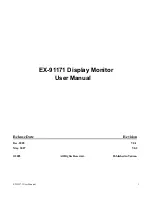
Chapter 3: Block Level Description
Advisor
®
Service Manual
3-5
Main Board - Memory
The five memory spaces are as follows:
Mbytes x 16 bit Flash memory (U22). This memory IC is the non-volatile, program memory space. At
•
power up, the contents of U22 is transferred to faster access SDRAM (U23, U24), from which program
code is executed.
Mbytes x 32 bit SDRAM, comprised of two 4 Mbytes x 16 bit chips (U23, U24). This RAM has fast access
•
and is used to execute program code, refresh the video display, and other scratch-pad functions.
56 kbytes x 8 bit of battery backed-up Static RAM (SRAM). The power to this memory space is backed-up
•
by supervisory IC (U7) and lithium coin cell battery (BAT1). This memory space is used for data that must
be retained at power down and/or during a system power failure.
56 kbytes x 8 bits EPROM (U26). This memory IC holds the program for the DSP. At power up the contents
•
of the EPROM are loaded into the DSP (U28)
Realtime clock IC (U2) contains 31 bytes of battery backed-up Static RAM (SRAM). The power to this
•
memory space is backed-up by supervisory IC (U7) and lithium coin cell battery (BAT1). This memory
space is used for data that must be retained at power down and/or during a system power failure.
Main Board - Video Generation
The ARM7 microprocessor has an on-chip LCD controller which generates all of the necessary signaling to the
LCD panel by way of connector J7. All signals to this connector have series ferrite chip beads to help reduce EMC
emissions. The controller is setup for 640 x 480 resolution, 25.126MHz pixel clock, 31.5KHz horizontal frequency
and 70 Hz vertical field rate.
Main Board - Audio Generation
The Main Board generates tone, volume, and speaker drive for audible alarms and other audible features. Audio
tone and volume control signals originate as Pulse Width Modulated (PWM) signals from the main processor
(U21). The signals are further signal-conditioned by U72 then amplified by a class-D audio amplifier (U14) to
efficiently drive an off-board 8-ohm speaker connected to J5. The speaker is mounted to the rear-half of the unit.
Main Board - Logic Power and Patient Isolation Power
The Main Board accepts DC power input on connector J10. Approxi12 VDC is present at TP12 (J10-1,3,5)
regardless if the unit is on or in standby/off mode. The source of the input DC voltage is either the output of the
universal AC to DC power supply or the rechargeable backup battery (if that option is installed and AC power
is off or not connected). Mosfet Q11 controls power to the rest of the Main Board by way of mosfet (Q5) and
keypad ON detection flip-flop (U6). Once Q11 is turned on, the PWM DC to DC controller IC (U19) soft-starts and
converts the input voltage to a reg5 VDC (TP22) by way of mosfet Q8, transformer T1, rectifier D2, and
capacitors C171 & C173. This voltage supply is the source for all logic supplies on the non-isolated Secondary
Extra Low Voltage (SELV) side of the Main Board. Segmented secondary windings on transformer T1 (pins 6, 8,
and 10) create the power for the patient-isolation side of the Main Board. The secondary windings meet UL2601
/ EN60601 creepage and clearance requirements to provide the required patient-isolation. Rectifiers D3 & D4,
and capacitors C168 & C169 create the unregulated isolated supplies at TP3 and TP4 and are nom/- 8 VDC.
Transformer T1 and capacitor C175 are critical components which should be replaced with identical parts.
Main Board - Thermal Printer Interface (optional)
The Advisor uses the XE-50 graphical thermal printer from GSI Lumionics when the printer option is installed.
The printer uses 2-inch wide paper and is capable of printing all numerical and graphical patient data. Internally,
a Printer Adapter Board connects directly to the printer and serves as an interconnect board for a ribbon cable
connection to the Main Board at J21. Portions of logic inverters U10 & U11 translate 5 V logic from the printer to
3.3 V logic for the Main Board UART (U74).
Summary of Contents for Advisor
Page 2: ......
Page 6: ...Table of Contents iv Advisor Service Manual This page is intentionally left blank ...
Page 8: ...Revision History vi Advisor Service Manual This page is intentionally left blank ...
Page 43: ...Chapter 4 Diagrams Advisor Service Manual 4 1 Chapter 4 Diagrams ...
Page 44: ...Chapter 4 Diagrams 4 2 Advisor Service Manual ...
Page 45: ...Chapter 4 Diagrams Advisor Service Manual 4 3 ...
Page 46: ...Chapter 4 Diagrams 4 4 Advisor Service Manual ...
Page 47: ...Chapter 4 Diagrams Advisor Service Manual 4 5 ...
Page 48: ...Chapter 4 Diagrams 4 6 Advisor Service Manual ...
Page 49: ...Chapter 4 Diagrams Advisor Service Manual 4 7 ...
Page 50: ...Chapter 4 Diagrams 4 8 Advisor Service Manual ...
Page 56: ...Appendix App 2 Advisor Service Manual This page is intentionally left blank ...
Page 57: ......
















































